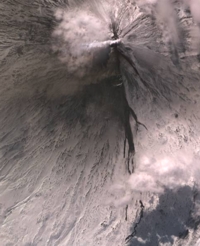Dr. Ramsey Awarded Volcano Related Grants from NASA & NSF
Associate Professor Michael Ramsey had been awarded two significant research grants from NASA and NSF.
 The newly-funded $577,000 NASA research expands upon a previously-developed critical processing pathway for data of natural disaster sites from the Advanced Spaceborne Thermal Emission and Reflection Radiometer (ASTER) sensor. The research team, from six different instutions around the world, proposed to both expand the operational aspect of the ASTER urgent request automation as well as increase the scientific return from the data acquired. These new processes and data will allow monitoring of large wildland fires and expand the volcanic observations by integrating other established regional monitoring programs (e.g., Central America, Russia). This work will also examine the effects of atmospheric aerosols (dust/ash) and climatologically-active gas species, as well as better constrain arc-wide volcanic flux and eruption rates thereby establishing a baseline for a longer-term observation, monitoring, and recovery for regions impacted by natural disasters. This new project will also continue the appointment of Ramsey on the ASTER science team and support one Ph.D.-level graduate student researcher.
The newly-funded $577,000 NASA research expands upon a previously-developed critical processing pathway for data of natural disaster sites from the Advanced Spaceborne Thermal Emission and Reflection Radiometer (ASTER) sensor. The research team, from six different instutions around the world, proposed to both expand the operational aspect of the ASTER urgent request automation as well as increase the scientific return from the data acquired. These new processes and data will allow monitoring of large wildland fires and expand the volcanic observations by integrating other established regional monitoring programs (e.g., Central America, Russia). This work will also examine the effects of atmospheric aerosols (dust/ash) and climatologically-active gas species, as well as better constrain arc-wide volcanic flux and eruption rates thereby establishing a baseline for a longer-term observation, monitoring, and recovery for regions impacted by natural disasters. This new project will also continue the appointment of Ramsey on the ASTER science team and support one Ph.D.-level graduate student researcher.
 The recent NSF award of $267,000 is a follow-on study that focuses on laboratory and field-based research to characterize the infrared contributions from fundamental Si-(Al)-O units in glassy lavas, and minerals/interstitial matrices of analog (synthetic) and natural silicic samples. The reserach team will carry out the first systematic characterization of the diagnostic absorption band positions and spectral shapes of these materials. The second task of the research will be to apply those results to field and satellite data of silicic domes. The intellectual merit of this work will yield the first laboratory TIR emission spectral measurements ever acquired of samples at temperatures above the solidus and the glass transition. By creating a suite of samples to better characterize silicic compositions, this work will more fully explore the TIR emission properties of volcanic lava domes and lead to the development of the next-generation of field-based monitoring tools. The project provides funding for one Ph.D.-level graduate student researcher.
The recent NSF award of $267,000 is a follow-on study that focuses on laboratory and field-based research to characterize the infrared contributions from fundamental Si-(Al)-O units in glassy lavas, and minerals/interstitial matrices of analog (synthetic) and natural silicic samples. The reserach team will carry out the first systematic characterization of the diagnostic absorption band positions and spectral shapes of these materials. The second task of the research will be to apply those results to field and satellite data of silicic domes. The intellectual merit of this work will yield the first laboratory TIR emission spectral measurements ever acquired of samples at temperatures above the solidus and the glass transition. By creating a suite of samples to better characterize silicic compositions, this work will more fully explore the TIR emission properties of volcanic lava domes and lead to the development of the next-generation of field-based monitoring tools. The project provides funding for one Ph.D.-level graduate student researcher.
For Dr. Ramsey's research page click here
For other Departmental News & Information click here
First Announced: December 15, 2007
|